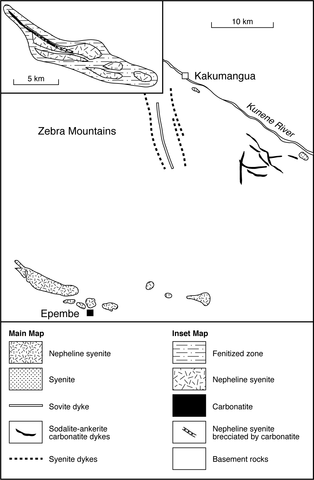stripes
The Epembe occurrence consists of five separate nepheline syenite intrusions and an elongate carbonatite body with an enveloping fenite zone. The overall length is 19 km with the largest nepheline syenite intrusion 8.2x1.4 km. The carbonatite intrudes and brecciates the largest nepheline syenite and basement rocks and occupies a zone up to 250 m wide and 9 km long. Dykes of nepheline syenite, ijolite and lamprophyre cut the nepheline syenites and are themselves traversed by late carbonatite dykes. The nepheline syenites are texturally variable but there may be some primary layering as indicated by contrasts of texture and mineralogy (Ferguson et al., 1975a). The most widespread nepheline syenite consists of perthitic microcline, nepheline variably replaced by cancrinite, biotite, sodic amphibole, aegirine-augite zoned to aegirine and accessory titanite, apatite and opaque oxides. The carbonatite ranges from fine-grained to coarse varieties in which carbonate grains are up to 5 mm across. Apatite is abundant, K-feldspar, plagioclase and biotite erratically distributed and magnetite, aegirine and riebeckite minor constituents. An apatite-rich micaceous ijolite which cuts the nepheline syenite contains clinopyroxene, brown biotite, nepheline, poikilitic titanite and plentiful apatite and opaque oxides. Ferguson et al. (1975a) investigated the fenites in detail and found that fenitization associated with the nepheline syenites differed from that associated with carbonatite, while fenitized gneisses reacted differently from fenitized amphibolites and gabbros. In all fenites quartz is replaced but the fenitization associated with carbonatite is characterised by widespread development of aegirine and riebeckite whereas that associated with the nepheline syenites led principally to the development of chlorite, epidote, titanite, sericite, new biotite, alkali feldspar, cancrinite and only occasional sodic amphibole. The bulk chemical changes during fenitization are followed using 45 analyses of rocks and partial analyses of biotite and plagioclase from fenites are also given; the nature of the fenitizing solutions and conditions of fenitization are discussed.
FERGUSON, J., MCIVER, J.R. and DANCHIN, R.V. 1975a. Fenitisation associated with the alkaline-carbonatite complex of Epembe, South West Africa. Transactions of the Geological Society of South Africa, 78: 111-21.MENGE, G.F.W. 1986. Sodalite carbonatite deposits of Swartbooisdrif, South West Africa/Namibia. In C.R. Anhaeusser and S. Maske (eds), Mineral deposits of southern Africa, 1: 2261-8. Geological Society of South Africa, Johannesburg.

